The Essential Fundraising Plan Template for Nonprofits
Craft your nonprofit’s next fundraising plan with these 7 expert strategies.
The Fundamental Fundraising Plan Template
Fundraising Plan Template
Fundraising is a challenging, but critical aspect of keeping your nonprofit afloat. It’s what allows your organization to earn the funds needed to grow over time and help more people.
As a professional fundraiser, whether you’re working with a brand-new nonprofit or an organization that’s been around for many years, you likely focus much of your energy and time on figuring out how to improve your fundraising strategy.
The most successful fundraisers will tell you that an effective fundraising strategy requires top-notch organizational skills to stay on track. A comprehensive fundraising plan template can make a major difference in your approach and provide the framework for more intentional, successful fundraising. Here at Aly Sterling Philanthropy, we equip nonprofits with the fundraising solutions they need to understand their donors better and ultimately raise more for their cause. Our consultants have constructed this fundraising plan based on years of experience.
Follow these comprehensive seven steps to create a fundraising plan that works for your organization:
- Determine your nonprofit’s fundraising goals.
- Outline your nonprofit’s budget.
- Create a fundraising plan calendar.
- Construct a gift range chart for your fundraising plan.
- Build your case for support.
- Define the logistics of your fundraising initiative.
- Delegate fundraising plan tasks to your team.
Keep in mind that while these tips are most easily applicable to major fundraising efforts such as capital campaigns, they can be adjusted to work for your annual giving program and other initiatives as well. These steps can also be adapted to work for nonprofits of all types and sizes.
Check out our free blank fundraising plan template below, and continue reading for step-by-step guidance through each fundraising aspect.

#1. Determine your nonprofit’s goals.
When crafting your nonprofit’s fundraising plan, identify specific, tangible goals that will help your organization succeed in its mission. These goals should be achievable and based on your strategic priorities and goals for the future.
Use a goal chart as a visual aid during this process. By recording your objectives with this tool, you can revisit them later on when building your fundraising plan.
Avoid focusing on fundraising benchmarks alone. In addition to fundraising aspirations, set goals to help you grow your community, improve donor retention, increase the number of major gifts you acquire, and more. The more varied your goals are, the better. Here are some examples of types of goals you might set:
- Major gifts: Major gifts are the largest contributions your organization receives. How many major gifts are you aiming to receive, and what amount would you like each gift to be?
- Donor acquisition: Donor acquisition refers to the number of new donors you secure over a given period. How many new donors would you like to engage throughout your fundraising initiative?
- Donor retention: Donor retention measures how many donors continue to give to your nonprofit from year to year and campaign to campaign. What donor retention rate are you aiming for throughout your upcoming fundraising drive?
For each goal, identify any obstacles that may stand in the way of achieving it. These might be time constraints, budget, the nature of your organization, or any number of additional potential roadblocks.
When you identify the potential obstacles, you can incorporate a strategy for tackling them into your overall fundraising plan.
If you are conducting a major campaign, this is the right time to undertake a feasibility study. It is recommended that you use a third-party consultant like Aly Sterling Philanthropy to conduct the study. These experts help determine if your organization is ready to take on a large campaign, how to prepare, and how much you can expect to raise. The feasibility study will survey your stakeholders to answer these questions:
- Is your cause compelling?
- Does the project/campaign make sense and provide a solution?
- Does the campaign have support among volunteer leadership and board members?
- Who are the potential campaign leaders?
- Are there any external concerns?
- Is now the right time for a campaign?
- How much should your organization expect to raise?
A feasibility study prepares you for your campaign by helping you develop realistic goals and proactively address obstacles. This helps your organization build a stronger case for support and generate excitement and support for the campaign among the people closest to it, such as donors, board members, and volunteers.
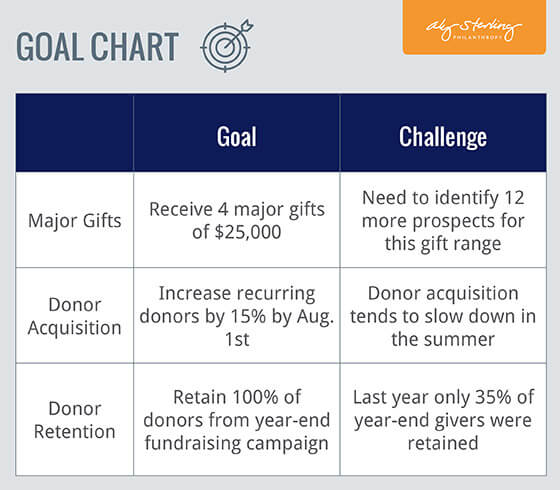
#1. Determine your nonprofit’s goals.

Lay out fundraising plan objectives with a goal chart.
When crafting your nonprofit’s fundraising plan, identify specific, tangible goals that will help your organization succeed in its mission. These goals should be achievable and should have an eye towards growth.
Use a goal chart as a visual aid during this process. By recording your objectives with this tool, you can revisit them later on when building your fundraising plan.
Do not just focus on fundraising benchmarks: set goals to help you grow your community, improve donor retention, increase the number of major gifts your acquire, etc. The more varied, the better.
With every goal you should also identify what obstacles may stand in the way of achieving it. These might be due to time constraints, budget, the nature of your organization, or any number of potential roadblocks.
#2. Outline your nonprofit’s budget.
An integral part of crafting your fundraising plan is settling on a budget. Your budget will ensure you don’t expend too much money while pursuing your fundraising goals, and it will be shaped by how effective your past budgets have been. For example, review the success of your last capital campaign or other major fundraising push to determine whether you allocated enough resources in your budget to achieve your goals.
Account for the sources of your income before allocating it to your various expenses. One way to clearly identify where funding will come from is by crafting a budget chart. This chart should reflect:
- Specific sources of income.
- Specific expenses.
- Income and expenses from previous fundraising drives.
With this information in hand, your team can better decide whether or not an expense is reasonable for your budget and craft your fundraising plan to account for trends from past budgets.
Make sure your budget also has the flexibility to account for any unexpected circumstances that arise throughout the initiative. Your budget should be as detailed as possible to keep your team on track and ensure nothing is left to interpretation.
Finally, craft your budget to be forward-thinking and use past results to predict future outcomes. This helps you keep an eye on expansion and maintain a positive outlook on the future.

#2. Outline your nonprofit’s budget.

How should funding be allocated across your nonprofit?
An integral part of crafting your fundraising plan is settling on a budget. Not only will this budget empower your organization to achieve your fundraising goals, but it will also be shaped by how effective your past budgets have been.
Account for the source of your income before allocating it to your various expenses. One way to clearly identify where funding will come from is by crafting a budget chart. This chart should reflect:
- Specific sources of income.
- Specific expenses.
- Income and expenses from previous years.
With this information in hand, your team can better decide whether or not an expense is reasonable for next year’s budget as well as craft your fundraising plan to account for trends from past budgets.
#3. Create a fundraising plan calendar.
Outlining a fundraising calendar is an essential element of developing your nonprofit’s fundraising plan.
Mark the dates of the start and end of your fundraising push, budget meetings, board meetings and more in this fundraising calendar.
Share this calendar across the different departments of your organization to keep everyone on the same page as you work through the tasks in your fundraising plan.
Having a detailed plan laid out in a calendar is especially important for large undertakings such as capital campaigns since these fundraising initiatives are split up into a series of phases, including:
- Planning Phase
- Quiet Phase
- Kickoff Phase
- Public Phase
- Conclusion and Follow-Up Phase
Each phase has a different timeline, so by noting each stage in your shared calendar, you can make sure your entire team is aware of where you are in the process.
Remain flexible when necessary, but use the calendar as a way to track the progress of your fundraising efforts.
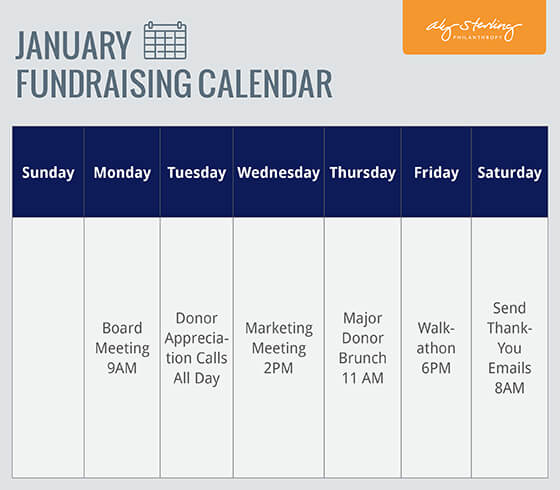
#3. Create a fundraising plan calendar.

Do you have a fundraising calendar in place?
Crafting out a fundraising calendar is an important part of developing your nonprofit’s fundraising plan.
Mark the dates of campaign beginning and endpoints, budget meetings, board meetings and more in this fundraising calendar.
Even further, your nonprofit should share this calendar across the different departments of your organization to help keep everyone on the same page when accomplishing the tasks in your fundraising plan.
Remain flexible when necessary, but try to use the calendar as a way to track the progress of your fundraising efforts.
#4. Create a gift range chart for your fundraising plan.
When developing your fundraising plan, your nonprofit should create a gift range chart to identify the donations needed to achieve your fundraising goals.
Gift range charts help nonprofits plan out efforts by breaking down fundraising goals into smaller, more manageable benchmarks.
So, how do you make a gift range chart? Here’s what to do:
- Break down your gift sizes. Specify different tiers of gifts as well as how many donations you’ll need to secure within each tier. The largest gift should make up 10-20% of your goal.
- Add the number of prospects you should contact for each tier. Include more than you really need. For example, if you need two donors to make the highest gift, reach out to four prospects.
- Note the cumulative totals for each gift amount.
With a gift range chart, your team can see:
- The size of gifts necessary to meet your goal.
- The number of prospects needed to supply these gifts.
- The total proportion of your fundraising goal accounted for in each gift level.
- The need for additional fundraising pushes you’ll need to meet your overall goal, like partnering with a product fundraising company to sell different items to your supporters or launching a peer-to-peer initiative on social media.
The major gifts at the top of your chart will take longer to cultivate, so it’s extremely helpful to know how many prospects you’ll need to connect with upfront.
Remember, when you’re conducting a major fundraising push like a capital campaign, you’ll know you’ve reached the end of the quiet phase when you’ve obtained 50-70% of the gifts outlined on your gift range chart.
Armed with this information, your team can be strategic when choosing which prospects to engage with during your fundraising effort. You can spend less time reaching out to supporters that aren’t needed to reach your fundraising total and ensure you do get in touch with the high-value supporters needed to help achieve your goal.
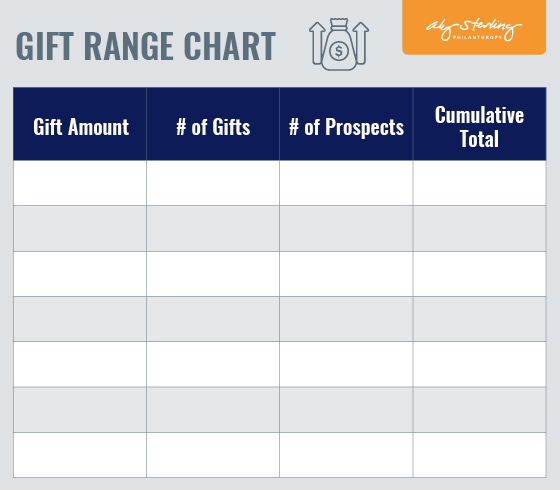
#4. Create a gift range chart for your fundraising plan.
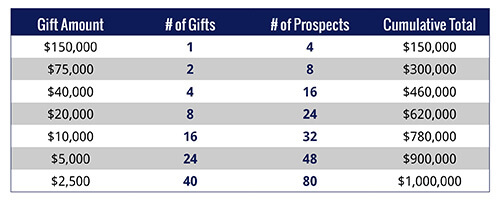
How will your fundraising goal be achieved?
When developing your fundraising plan, your nonprofit should create a gift range chart to identify what is necessary to achieve your fundraising goals.
Gift range charts help nonprofits plan out campaigns by breaking down fundraising goals into smaller, more manageable benchmarks.
With a gift range chart, your team can see:
- The size of gifts necessary to meet your goal.
- The number of prospects needed to supply these gifts.
- The total proportion of your fundraising goal accounted for in each gift range.
Armed with this information, your team is better able to identify prospects for giving, which provides you useful information to use when crafting your constituent engagement strategy.
#5. Build your case for support.
Prospects need to have a compelling reason to give to your organization. There is no better way to grab their attention than by creating a dynamic case for support.
Your case for support needs to be specific and actionable— no one wants to give their money to an organization that doesn’t have a clear direction for using those funds
Your case for support should include:
- A clear mission statement.
- A brief history of your nonprofit.
- Your specific fundraising goals.
- Your gift range chart.
- A detailed overview of what your organization will achieve with donor support.
This should be one of the first tasks your team works on so you can prepare all your marketing materials and donor information packages before the fundraising initiative kickoff. You can create a branded case brochure that delivers prospective donors everything they need to know about the initiative in a professional, detailed package.
Also, community-specific appeals can highlight how a nonprofit impacts a community and how its network of local support is integral to the organization’s success. Check out how Aly Sterling Philanthropy serves the Cleveland, Ohio area to get an idea of how a local consultant can impact your team’s fundraising approach. A consultant can help you articulate your needs and craft a donor-centric fundraising appeal that’s informed by the fundraising landscape of your local area.

#5. Create your case for support.

What is your case for support?
Prospects need to have a compelling reason to give to your organization and there is no better way to grab their attention than by creating a dynamic case for support.
Your case for support needs to be specific and actionable – no one wants to give their money to an organization without clear direction.
Your team should be sure to include:
- A clear mission statement.
- A brief history of your nonprofit.
- Your specific fundraising goals.
- Your gift range chart.
- A detailed overview of what your organization will achieve with their support.
Community-specific appeals can highlight how a nonprofit impacts a community and how their network of local support is integral to the organization’s success.
Check out how we serve the Cleveland, Ohio area to get an idea of how a local consultant can impact your team’s fundraising approach.
#6. Define the logistics of your fundraising push.
Your team should ensure that you do not encounter any surprises throughout your fundraising efforts. The best way to be prepared? Diligently breaking down the logistics of your upcoming fundraising projects.
Using a planning chart, identify as much relevant information as you can relating to your projects, such as:
- Date, time, location and attendance.
- The cost of the project (payroll expenses, marketing budget, cost of the venue, etc.).
- Goals associated with your projects.
By taking the time to lay out this information, you can marry your budget with your calendar to ensure you stay on track financially throughout the entire process.
Plus, your team can more effectively delegate tasks among departments, set aside money in your budget for these projects and overcome potential roadblocks before they pose a real issue.
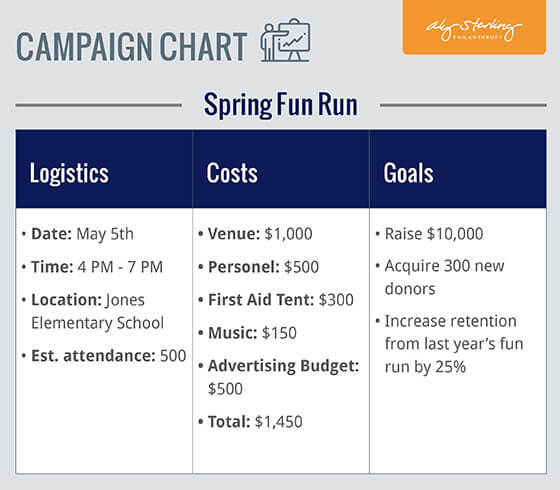
#6. Plan out your campaign.

How will you execute your fundraising campaign?
Your team should ensure that you do not encounter any surprises over the course of your fundraising campaign. The best way to get prepared? Your nonprofit should diligently break down the logistics of your upcoming fundraising projects.
Using a campaign planning chart, identify as much relevant information as you can relating to your projects, such as:
- Date, time, location and attendance.
- The cost of the project (payroll expenses, marketing budget, cost of venue etc.).
- Goals associated with your projects.
By taking the time to lay out this information, your team can more effectively delegate tasks among departments, set aside money in your budget for these projects and overcome potential roadblocks before they pose a real issue.
#7. Delegate fundraising plan tasks to your team.
To successfully achieve your fundraising goals, your nonprofit should delegate fundraising activities across your organization. One way to optimize role delegation is to use a calendar matrix.
A calendar matrix helps team members in varying roles stay on top of their work by outlining fundraising activities by department.
In your calendar matrix, include logistical details to improve your team’s understanding of the big picture of your fundraising initiative. These details may include:
- Costs associated with events or projects.
- Anticipated fundraising income from each activity.
- Personnel required to carry out activities.
- Deadlines and benchmarks associated with each task.
Every team member should contribute to achieving your nonprofit’s fundraising goals. By using a calendar matrix, you help those in different departments see how their work fits into the big picture of your organization.
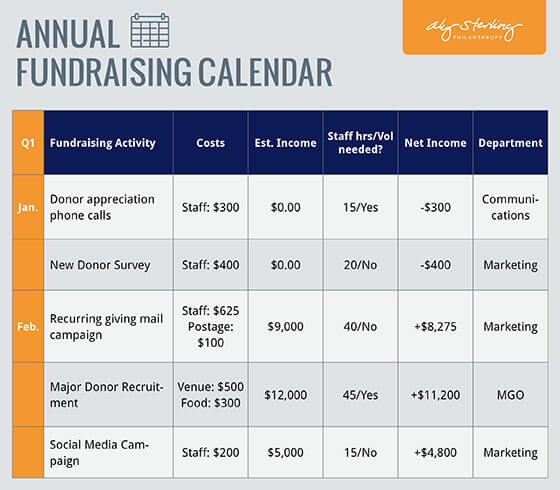
#7. Delegate fundraising plan tasks among your team members.

Who is responsible for your campaign tasks?
To successfully achieve your fundraising goals, your nonprofit should diligently delegate fundraising activities across your organization. One way to optimize role delegation is to use a calendar matrix.
A calendar matrix helps team members in varying roles across your nonprofit stay on top of their work by outlining fundraising activities by department.
In your calendar matrix, include logistical details to improve your team’s understanding of the big picture of your fundraising campaign. These details may include:
- Costs associated with events or projects.
- Anticipated fundraising income from each activity.
- Personnel required to carry out activities.
Every team member should contribute to achieving your nonprofit’s fundraising goals. By using a calendar matrix, you help those in different departments see how their work fits into the big picture of your organization.
Wrapping Up & Additional Resources
By following these seven steps, your team should have the foundation it needs to tackle your fundraising efforts and successfully meet your goals. Crafting your strategic fundraising plan may take a lot of effort up front, but it’s worth it in the end because it provides the structure needed to keep your team on task throughout the entire fundraising push.
For additional help building your fundraising strategy, check out these resources:
Hiring a Fundraising Consultant

Consult these expert tips when choosing your fundraising consultant!
Nonprofit Feasibility Studies
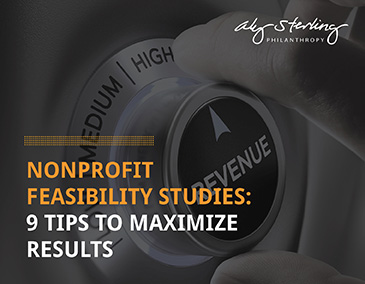
Make the most of your feasibility study with our 9 helpful strategies!
The Ultimate Capital Campaign Guide

Check out our guide to help your nonprofit reach its large-scale fundraising goals!
PO BOX 140668
TOLEDO, OHIO 43614
The Nonprofit Store
Your one-stop-shop for high-quality, affordable DIY tools focused on fundraising, strategic planning and board governance.
News & Resources
Sign up for our email newsletter and receive FREE resources, exclusive tips, news and offers!
Have A Question?
Contact us for more information about our services and how we can help your mission.
THE NONPROFIT STORE
Your one-stop-shop for high-quality, affordable DIY tools focused on fundraising, strategic planning and board governance.
NEWS & RESOURCES
Sign up for our email newsletter and receive FREE resources, exclusive tips, news and offers!
HAVE A QUESTION?
Contact us for more information about our services and how we can help your mission.